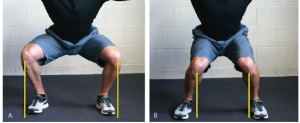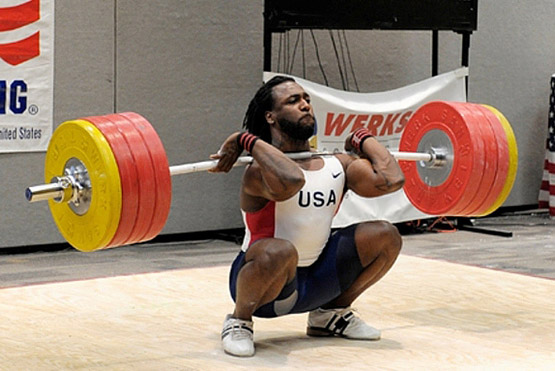The Front Squat
It's like sitting in a chair for a nice dinner, isn't it? Company has arrived, the table is all set, and the meal is steaming and ready. You bend at the knees, sit your hips back slightly, and keep your chest up as you go... eyeing what food awaits.
So why is it so difficult when we ask the body to hold a weighted object at the chest and travel below a parallel line of action?
As I initially touched on the topic of Squats in an article back in 2012, I acknowledged that in many senses we were all born to squat. Check out any toddler as they play or pick up items from the ground.
Heels down, knees out, chest up.
In the case of a developing child, the body moves in a correct pattern because of its attempt at finding strength and efficiency.
The culprit for adults, therefore, is life. Specifically, a stereotypical sedentary adult towards the opposite side of life's spectrum from the toddler above can incur years of bad motor patterns, due in large part to travel, work, and leisure habits. Not to mention one too many episodes of seconds and thirds at the dinner table. This can result in lack of strength, conditioning, and create major mobility issues that take time and patience to correct.
To the point: the compound movement of the squat is responsible for such important muscle growth and athleticism that it is a benchmark lift in any exercise program across the world. It is also one that can provide a lot of frustration at one's own body.
Heels down, knees out, chest up. A lack thereof? Mashed potatoes.
As with any physical movement, you put some work in, get good cues from a coach or through a little research, and your body adapts. Put time, and weight, to your squats and you'll surely benefit.
If we pick at the bone of some variations of the squat, we can get some juicy details for the beginning athlete and hopefully some good reminders for the experienced one as well.
The Front Squat. A small step in front of its cousin the Back Squat in terms of difficulty for the public, the Front Squat is one that deserves attention in the Olympic Lifting and CrossFit community because of its direct carry over to the Clean. It is also one that we don't find in high use in generic gym settings compared to the Back Squat.
The difficulty typically lands in issues of trunk strength in the midline to counteract the propensity to let any weight take the spine out of good posture. In other words, it's hard to hold weight in the right position without losing core stability.
The other difficulty is to correctly coach an athlete who is lacking in one or more essential areas of Front Squat safety and mechanics.
To clear up one basic premise, we will focus on the barbell Front Squat from here on out. While a myriad of other objects can take the place of a bar (kettlebell, medicine ball, heavy bag, a 2-year-old, etc), this will help for the sake of simplicity.
Let's look at a few important items to consider when trying to improve Front Squat mechanics and consistency.
Tips for a Successful Front Squat:
1. Hand and Arm Placement Our default here will be to squat in a Clean grip. This is to mimic picking up a bar from the ground and shouldering the load to stand up. This, versus a crossed-arm variation which can be easier on those athletes with flexibility issues or previous injuries, is generally a tougher bar position but one we want to infuse in the brain and body if utilizing Oly Lifting as well.
Cue: Elbows Up. [Mobility Video]
- Release your grip. Do not death grip the bar; instead let it sit on the deltoids in the fingers.
- Work on latissimus and thoracic spine mobility, not just wrist flexion and extension, so that the elbows can fire up and across the room with imaginary lasers firing through the farthest wall. This will be crucial at the bottom of the Front Squat as you drive up out of the hole of the squat.
- Let the elbows lead the way, as if marionette strings are attached and pulling you upwards.

2. Leg and Knee Action This will obviously change a bit because of human body variance. Meaning, one person's squat stance will look a little different than the next. Same on knee position through the squat. In essence, squats are like snowflakes; every one is unique.
Cues: Heels down, knees out. [Mobility Video]
- Keeping the heels grounded will help create a full foot drive but will also maintain knee health.
- Knees out. Debates circulate regarding the "knees out" cue. A natural valgus knee action while standing will occur in everyone. Find a good coach to help with this cue. For general use, though, drive your knees out as you stand.

3. Spine Position
Cue: Chest up. [Mobility Video]
- This cue is not meant to be tricky or confusing. It is simply to help maintain and upright posture throughout the full movement.
- The opposing action is also helpful as this sets the lumbar back in a strong, stable position, able to handle the load of the barbell up top.

Find more Front Squat resources. Items left might be how often to squat (timing), and how/when to go heavy (progression). There are many great sources of info out there regarding squats, so check into things if you have the time and interest.
Starting Strength (with Mark Rippetoe): Recommended Reading
Elite FTS (with Dave Tate, et al):Recommended Reading
California Strength (with Glenn Pendlay):Recommended Reading
Catalyst Athletics (with Greg Everett):Recommended Reading
There it is. A detailed look at tips and resources for the Front Squat.
If there's still not enough on your squat plate, what's left on the table? Decide on the meat of your strength programming, sprinkle in some sides of conditioning and skill work, and always leave room for dessert.
-Scott, 7.13.2015





